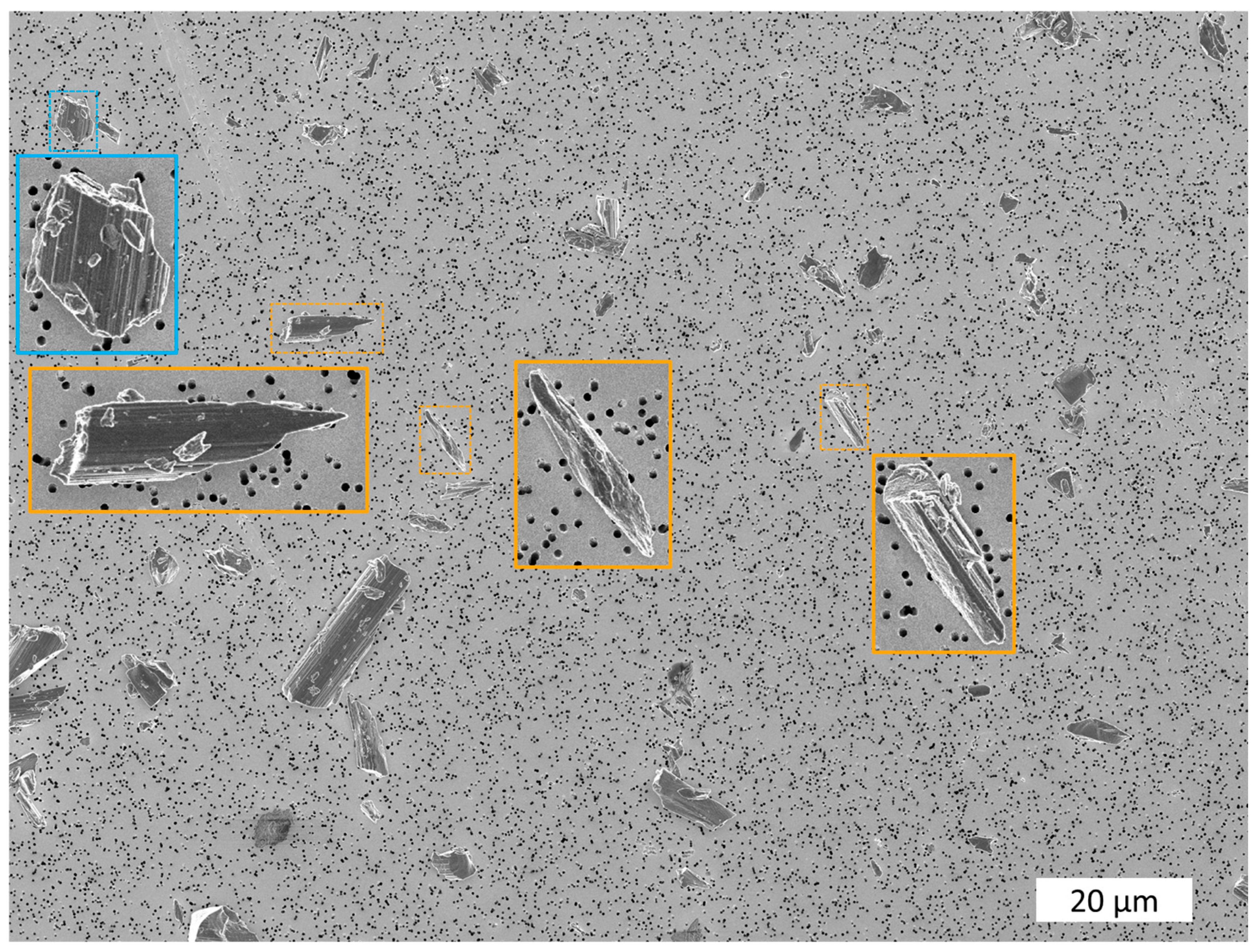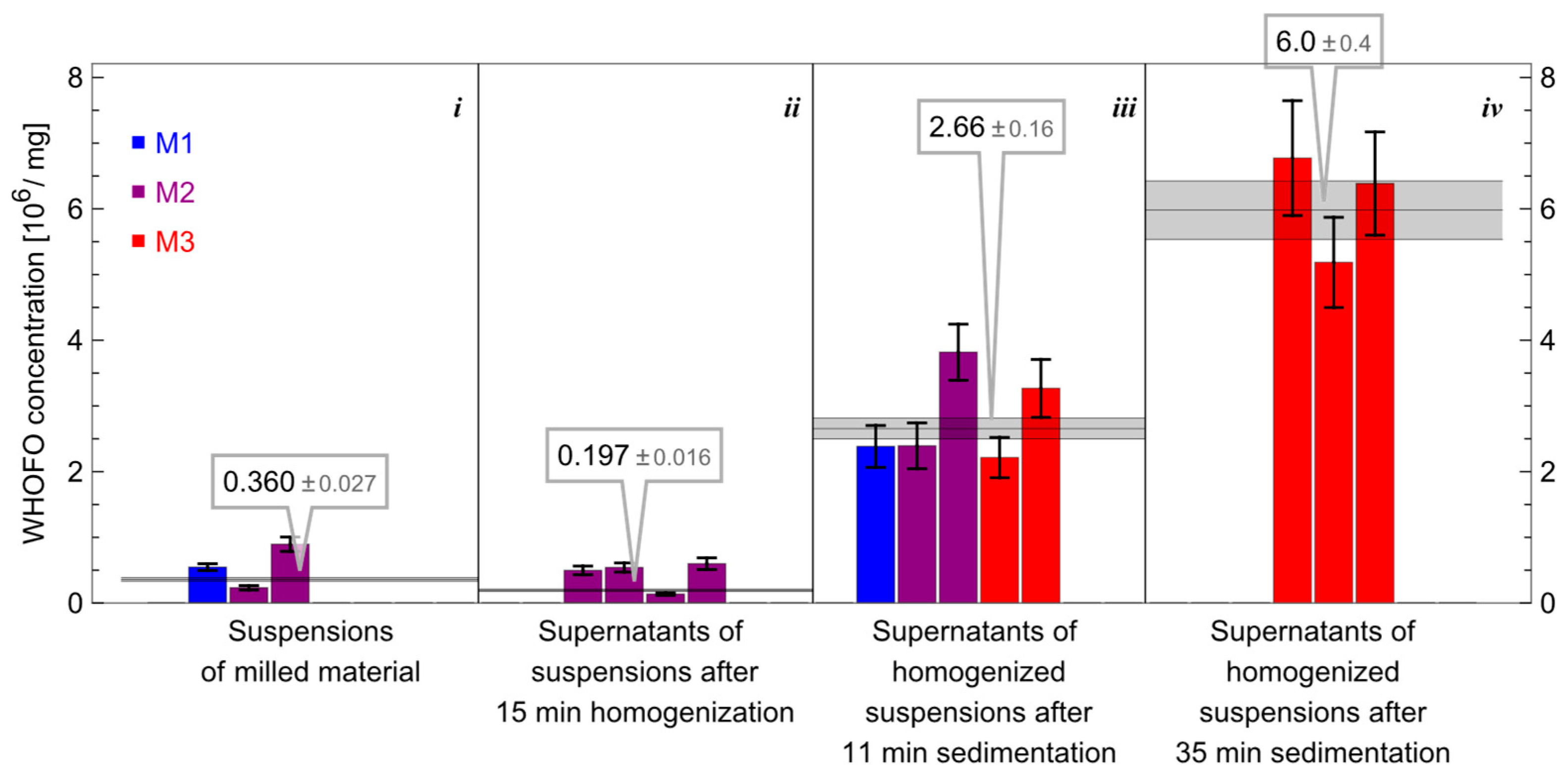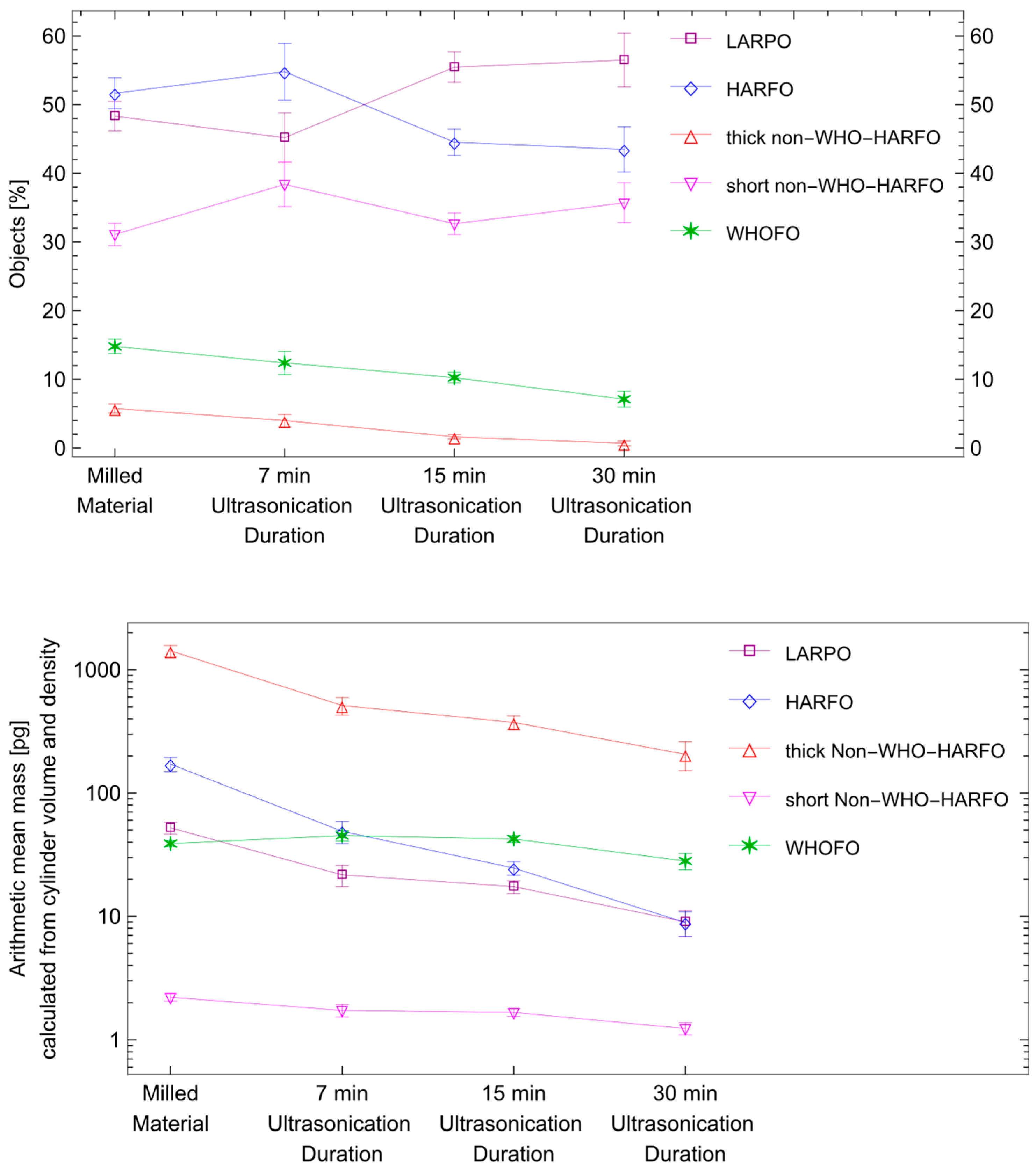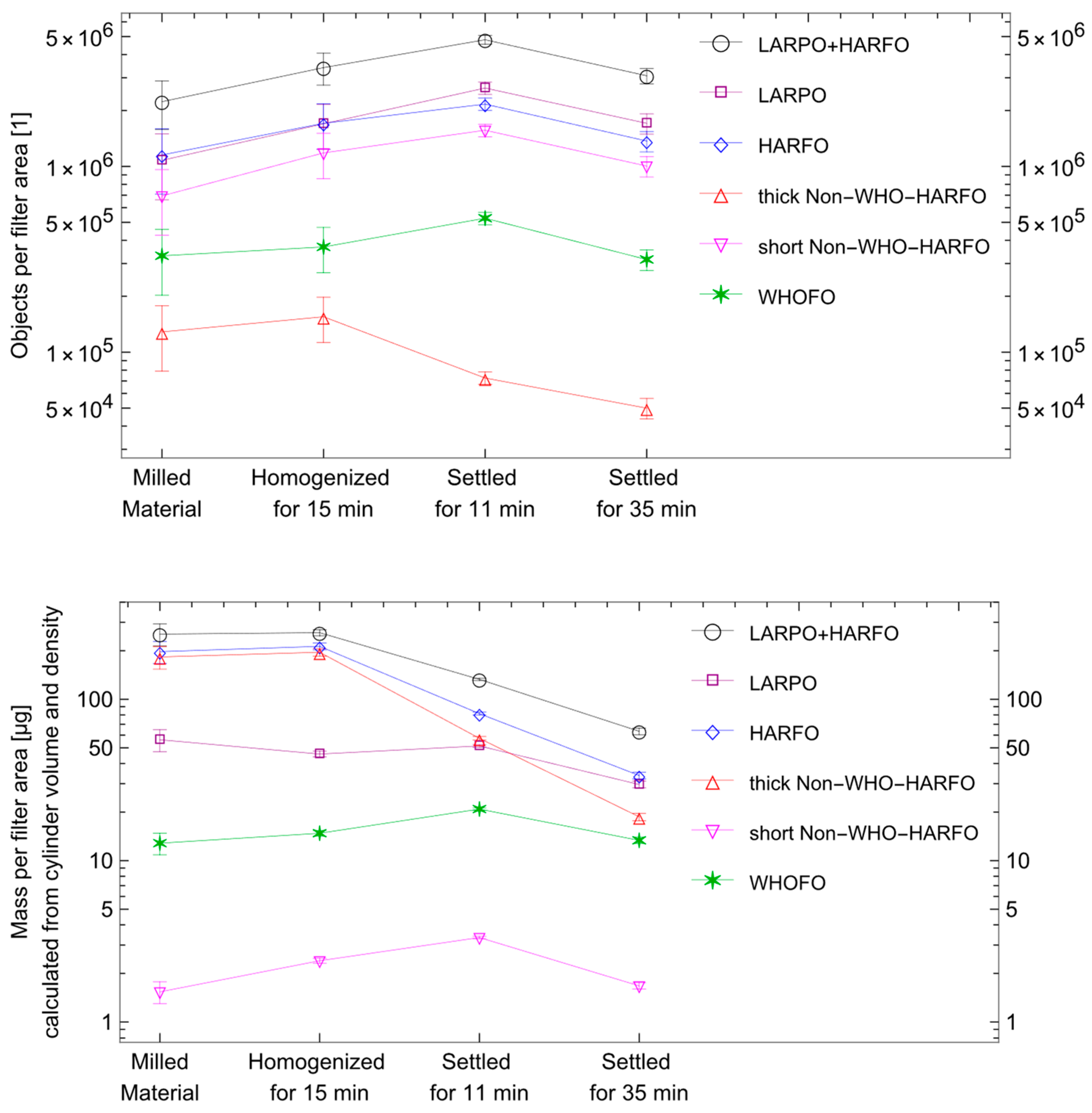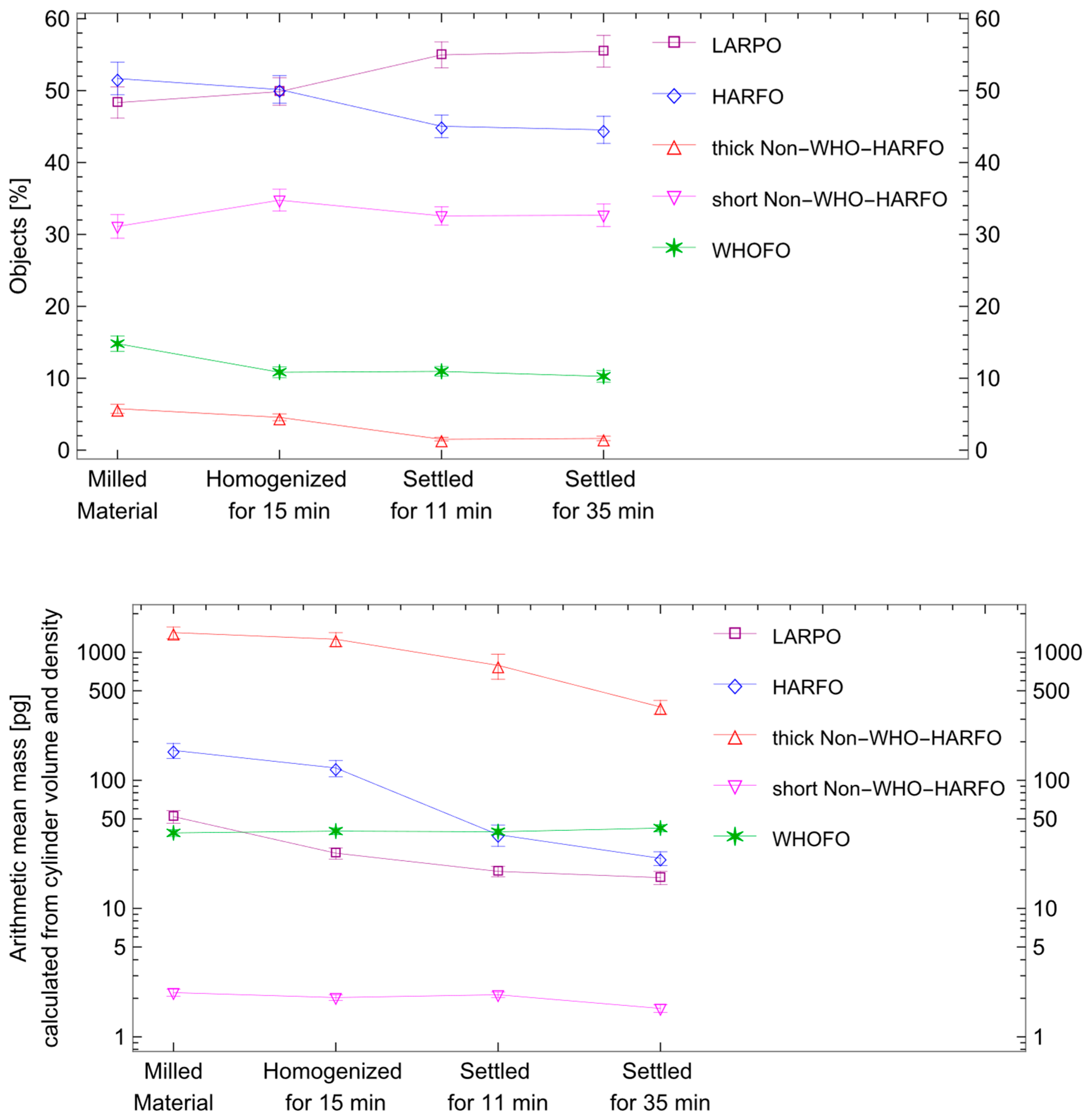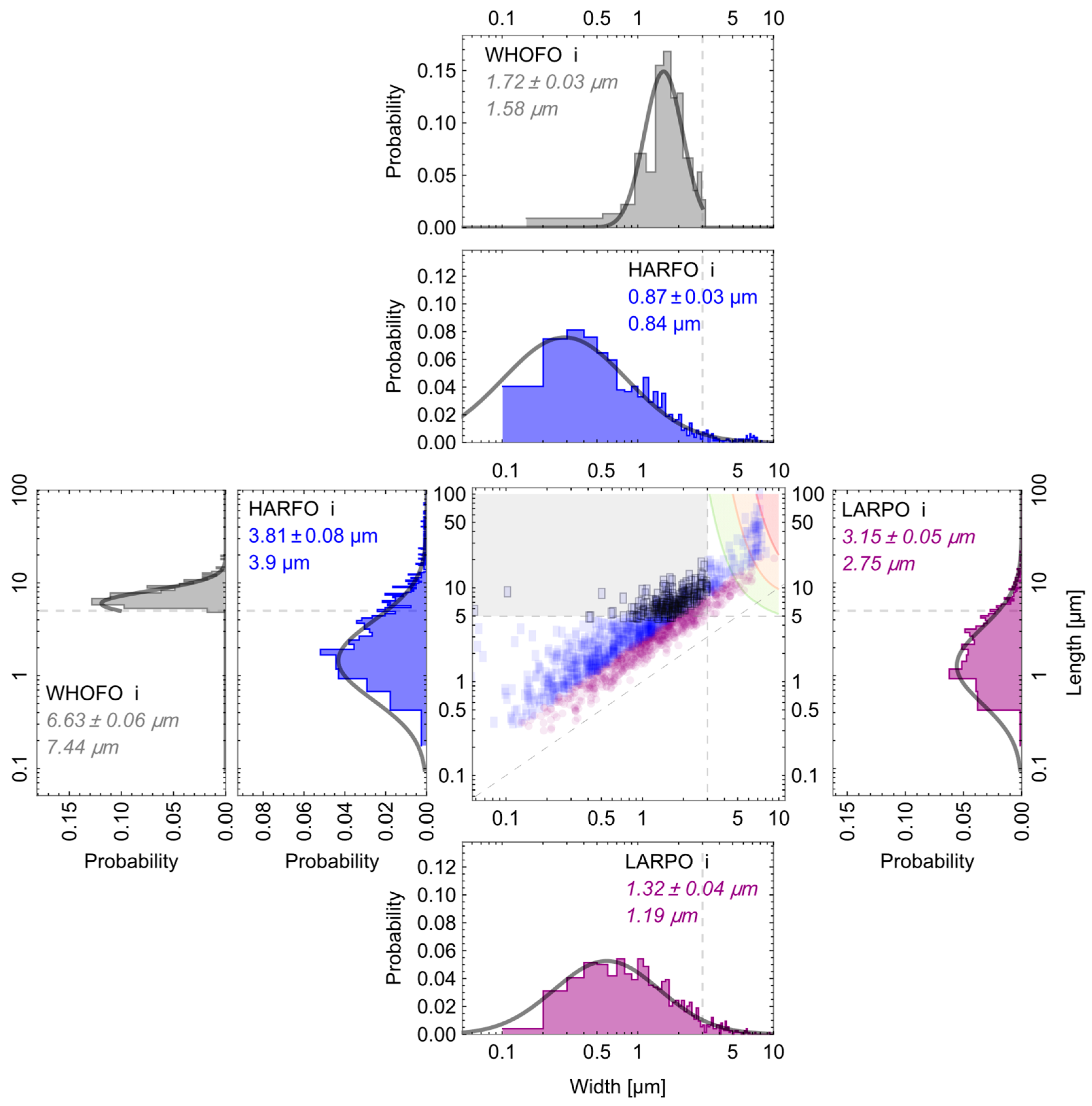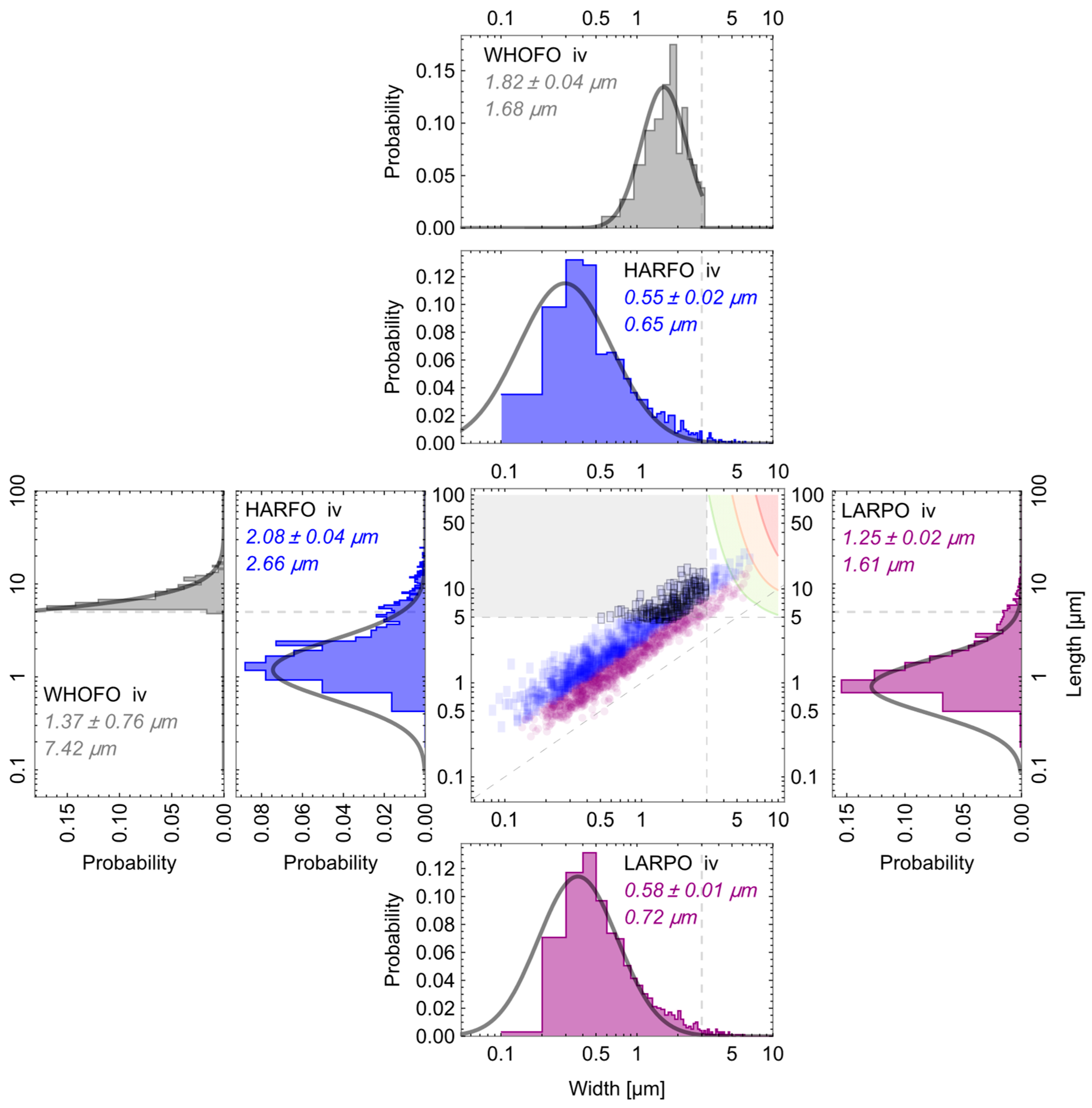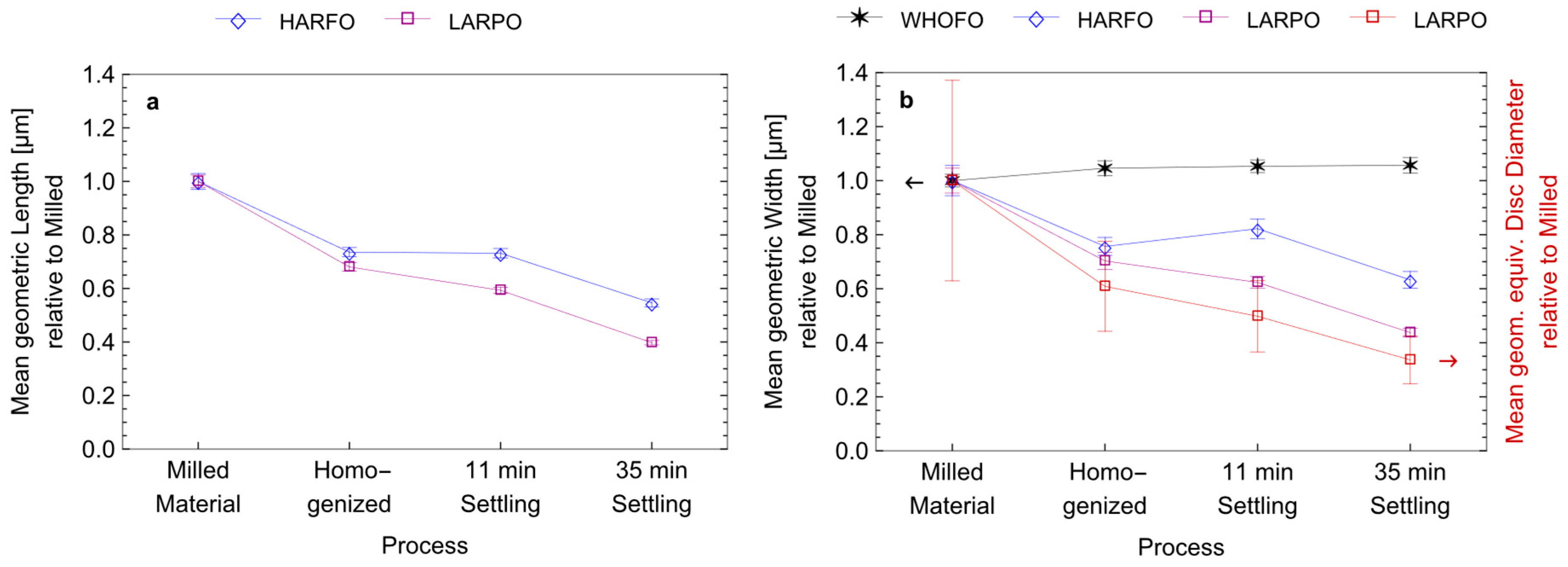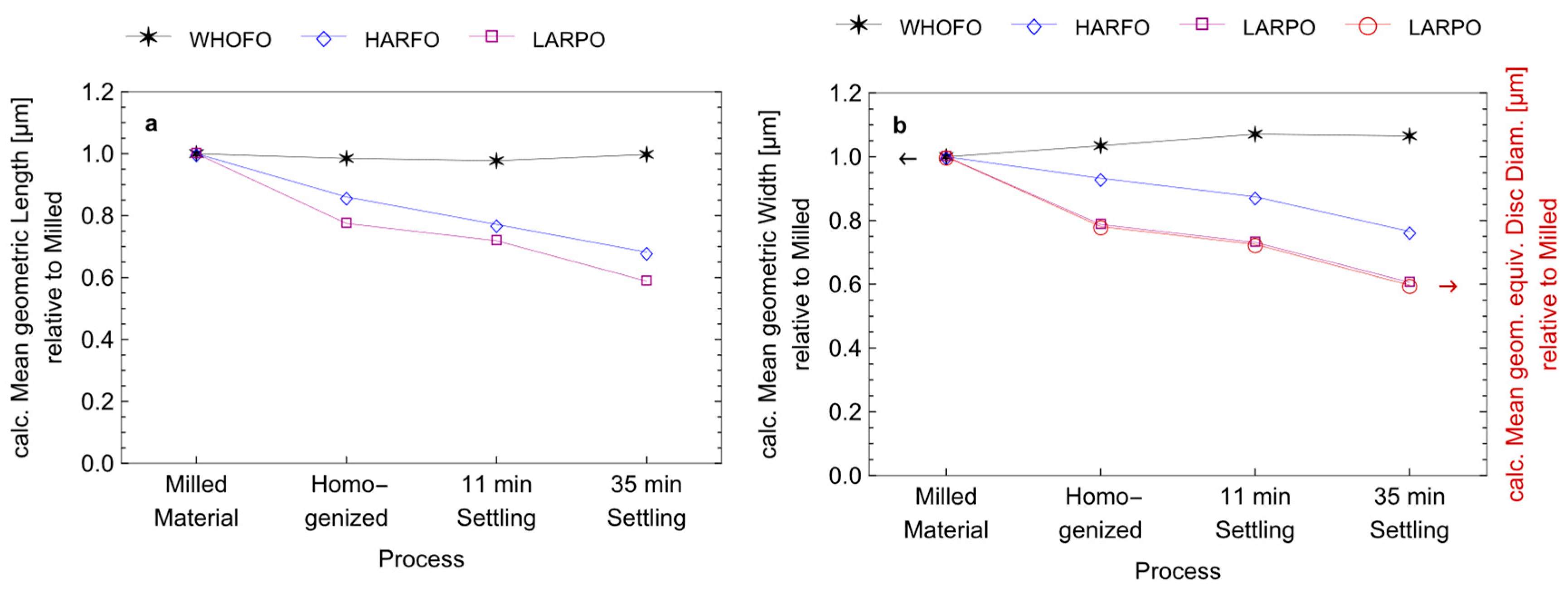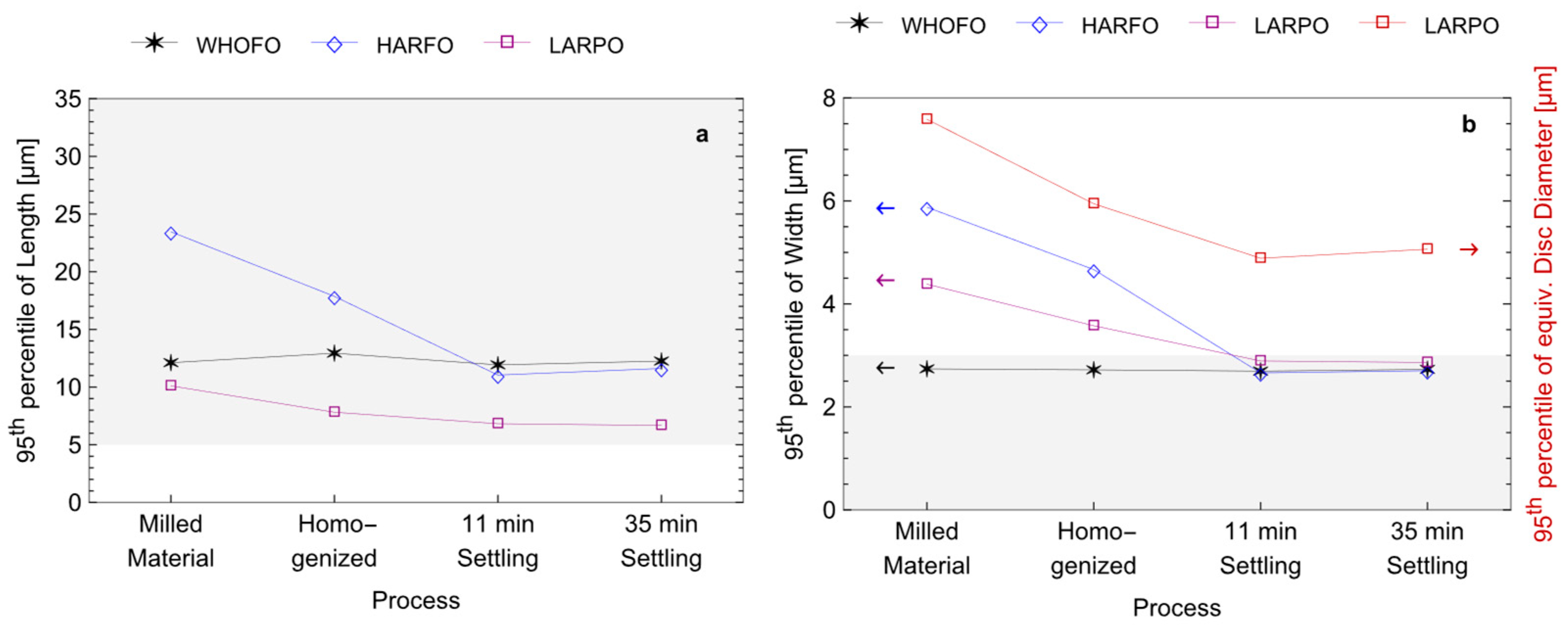1. Introduction
Carbon fibers (CF) are mainly used in composite materials for lightweight high-performance structural components [
1]. Compared to other precursors, polyacrylonitrile-based (PAN) CF are the most widely used variant and are produced in high volumes [
2]. They are spun from polymer solution with resulting diameters of typically greater than
and are thus initially non-respirable by design. However, despite their excellent mechanical properties, structural failure of CF or CF-containing composites can occur during manufacture, handling, use and recycling. Carbon fiber disintegration results in the formation of granular and fibrous fragments that are of concern to human health if respired at critical doses.
In contrast to the widespread use of CF, there are only limited data from epidemiological and toxicological studies on the hazard of CF fragments and only sparse data on exposure to CF-derived dust [
3,
4,
5,
6,
7,
8,
9,
10,
11,
12]. Consequently, no CF-specific occupational exposure limits (OELs) have been implemented. However, being carbonized and partially or highly graphitic materials, CF are inorganic materials that must be considered to exhibit high biodurability. Accordingly, respirable fibrous and granular particles contained in CF-derived dusts can persist and accumulate in lung tissue. Granular CF dusts are therefore subject to general occupational hygiene regulations for inert dusts. Such regulations aim at preventing overexposure-related health effects by imposing mass-based exposure limits. Fibrous CF fragments are to be treated as inorganic fiber dusts with, in many countries, mandatory fiber number-based exposure limits. For example, the German “Technical Rules for Hazardous Substances” (TRGS 905) [
13] recommend that all inorganic fiber dusts containing respirable fiber-like particles with specific dimensions of concern in terms of width, length and aspect ratio are to be classified as suspected carcinogenic according to category 2 of the European CLP Regulation (“Classification, Labelling and Packaging”) [
14], unless sufficient toxicological data indicate non-toxicity. A material classified in category 2 can be declassified with a negative test result at both a dose of
and a higher dose of
fibers per rat using intraperitoneal testing [
13]. To classify a material as presumably carcinogenic according to Category 1B (“Presumed to have carcinogenic potential for humans, classification is largely based on animal evidence.”), the corresponding guideline for toxicological testing [
13] requires a positive test result at a dose of
fibers.
The specific fiber dimensions of concern include fibers with a length
, a width
and a length-to-width aspect ratio greater than 3. These limits are also referred to as “WHO dimensions”, as they include those fibers that are to be counted according to the WHO fiber counting convention [
15]. However, since the WHO counting convention must also be executable with phase-contrast optical microscopy, it does not count fibers thinner than
. The term “WHO-analog” fibers will therefore be used subsequently.
In general, the tendency of a material to form fiber-like fragments depends on both the intrinsic anisotropic structural properties of the material and directional aspects of the disintegration-causing processes. Due to the increasing production, compounding and use of CF, a risk-based material classification seems necessary. In particular, the ongoing upscaling of the recycling of CF-reinforced composites, including technologies such as chemolysis, pyrolysis, shock wave application or Joule heating [
16], leads to new release scenarios and potentially higher occupational exposure to CF-derived dusts.
In order to comply with occupational hygiene requirements, both an improved understanding of the toxicology of CF-derived dust particles and the efficacy of measures to control exposure to biodurable respirable fiber dust are necessary. While occupational risk assessment considers both the respired dose resulting from the release and exposure to fiber dusts, as well as fiber dust-specific hazards, hazard assessment alone is not concerned with the likelihood of fiber fragments formation but whether it can occur at all.
In intraperitoneal (i.p.) testing, a fiber suspension is injected into the peritoneum of rodents. The animals are subsequently observed for two years and investigated histopathologically for the occurrence of mesotheliomas. According to Ref. [
17], all asbestos fiber types that caused mesotheliomas in humans, as well as all asbestos and manmade mineral fiber types that caused mesotheliomas in experimental animals after inhalation exposure, also caused mesotheliomas after i.p. injection in rats [
18,
19,
20,
21,
22,
23,
24]. Despite the long history of fiber toxicological testing, the selection of appropriate tests is subject of ongoing discussion [
25,
26]. Some authors have reported a lower sensitivity of rats towards asbestos in inhalative compared to intraperitoneal application (see Figure 3 in Ref. [
27]).
Although the systemic administration of fibers and particles bypasses physiological exposure pathways, it is widely accepted that direct intravenous or intraperitoneal injection of particles serves as a reproducible, valid and convenient method for investigating translocation mechanisms and biological responses [
28].
Intraperitoneal tests in rats are considered specific for the carcinogenicity of biopersistent fibers and are accepted by EU regulatory authorities to investigate whether a fiber material can induce pleural or peritoneal tumors [
29]. In contrast to fibers, biopersistent granular dusts were not able to induce mesotheliomas in this test, even when applied at very high doses of 4 × 20 mg per rat [
30].
Test materials to be used for in vivo or in vitro toxicological studies that aim at identifying the hazards of a specific material must meet very high standards with respect to chemical and morphological characterization, endotoxin contamination, etc., especially when selected for inhalative, instillative or intraperitoneal application in rodents, also for ethical reasons. Even more challenging are the requirements for materials that allow differentiation between fiber and particle overload-related toxic effects in in vivo application, as the dose ratio of fibers to granular particles must be carefully controlled. This requires the laborious compilation of statistically representative morphological distributions of fragment length and width by means of microscopic analysis. In addition, the guideline for i.p. testing limits the total injected mass to a maximum of
per animal [
29]. A test material must therefore provide a dose of at least
fibers of WHO-analog dimensions per
sample material for the lower test dose of
fibers per animal. Since i.p. studies are usually performed with at least 50 animals per dose level, this can result in a demand for the test material on a multigram scale. This excludes small-scale separation techniques and requires a moderate-to-high separation yield, along with a reasonable throughput per separation run.
Various techniques have been developed to generate fibrous test material from particulate matter (PM) for use in toxicological testing, including the use of sophisticated electrostatic precipitators as PM collectors [
31,
32] and of differences in gravitational settling, as were reported for airborne microplastic fibers [
33]. Ball milling was found to be a less sophisticated but still effective source of fibrous CF debris when applied to various CF materials [
34]. Both PAN-based and mesophase pitch-based CF disintegrated into fibrous fragments. Ball milling of a highly graphitic pitch-based CF produced a material with such a high content of WHO-analog fibrous fragments that it was directly subjectable to a fiber toxicological i.p. study in rodents. A publication on the results of this study is currently in preparation [
17]. PAN-based CF showed a smaller but still significant tendency to form WHO-analog fragments compared to pitch-based CF [
34].
The present work reports the results of a systematic study to enrich the fraction of WHO-analog fibrous fragments in ball-milled PAN-based CF samples to a level that allows to supply test material for toxicological i.p. studies that aim at the differentiation of fiber- and particle-related toxic effects. The range of process parameters that could be investigated in the present work for process optimization was comparatively large, as the laborious compilation of morphological distributions was supported by automated microscopic image acquisition and semi-automated fragment analysis.
3. Results
The milling and separation procedures were optimized to maximize the number concentration of WHO-analog fibers per sample mass while, at the same time, keeping the amount of work for the preparation of the amount of material needed for the in vivo study manageable.
WHOFO enrichment experiments were conducted with differently milled specimens, varied sedimentation durations and varied cut-off volumes, as well as with and without ultrasonic homogenization. The results of sequences of up to five replications of experiments varying the ultrasonication and gravitational settling duration are reported in
Table 1 and visualized in
Figure 2. Replications were conducted to study the reproducibility of the applied sampling and morphological characterization procedures. Upon milling pre-cut PAN-based CF, dispersing them in 2-propanol by shaking and sampling on filters, as described in
Section 2.2.2, it was observed that the ground material tended to form agglomerates and covered the filters for SEM analysis inhomogeneously. Representative sampling on filters for SEM analysis proved difficult. Filter sampling and evaluation resulted in large variations of the number of WHOFO per mg sample (cf. the results of group i in
Table 1).
Ultrasonication of the liquid suspension prior to the gravitational settling process improved both the sampling repeatability and the dispersion state. Treatment durations between 0 and 30 min were studied. Long treatment durations of
caused considerable additional fragmentation, as they reduced the average mass of all fragments, especially that of WHOFO. The results for the object percentages and the arithmetic mass of the studied morphological classes are shown in
Figure 3. It was found that the maximum number concentration of WHOFO per mass was obtained after 15 min of ultrasonication. The scatter plots and their histograms of results of different ultrasonication durations are shown in
Figure S5 in the Supplementary Information. They show a shift to shorter lengths and thinner widths with increasing ultrasonication time that is represented in the calculated geometric mean values. This duration was used in subsequent sedimentation duration variation experiments.
Suspension homogenization with an ultrasonic treatment of
improved the reproducibility of the determination of the WHOFO number concentration per mass in
Figure 2 and
Table 1 and enabled significant increases for prolonged gravitational settling duration. The
WHO-analog fibers per mg material that are required for i.p. testing were achieved after a settling duration of 35 min (group iv).
The number of WHO-analog fibers per mg sample can increase with the settling duration if the total mass of all other objects, i.e., LARPO and non-WHO-HARFO, decreases faster than that of the WHOFO and, at the same time, the number of WHOFO does not decrease significantly faster than that of the other objects. The former is generally expected, as settling is faster for larger objects.
In order to better understand the increase in the number of WHOFO per mg sample during settling, the number of objects per filter area and the process yield in mass per filter area were calculated (cf.
Figure 4). As these data sensitively depend on the correctness of the total mass on the filter, the more robust relative measurands object percentage and arithmetic mean of object mass were also calculated and plotted in
Figure 5.
The individual object mass was estimated from assuming a simplified cylindrical fragment geometry of length
and diameter
together with a specific CF density of
. Please note that this calculation tended to overrate the true mass in
Figure 4, as the maximum mass per filter was
(cf.
Section 2.2.5). This can be understood by
Figure 1, which shows that the majority of fragments exhibited rather an irregular or wedge-like shape than a cylindrical shape.
After homogenization by ultrasonication, the total number of objects per filter area increased as a consequence of the effective separation of agglomerated fragments (
Figure 4 top). For a settling duration of 11 min, the number of the largest objects, i.e., the thick non-WHO-HARFO objects, was promptly and significantly reduced. Prolonging the settling time to 35 min also yielded a reduction in the number of all other object classes, including the next-largest particles, the WHOFO.
When analyzing the overall yield of the process as mass per filter (cf.
Figure 4 bottom), it becomes evident that the settling procedure reduces the mass yield, and this effect becomes more pronounced with a longer settling duration. It is driven mostly by a reduction in thick non-WHO-HARFO fragments. The necessity of producing an amount of multiple grams in total for the in vivo experiments therefore forced us to limit the settling duration to
as any prolongation would further reduce the yield of WHO-analog fibers per experiment. This would have increased the number necessary of production runs to a no longer manageable quantity. About
of refined material were filtered from
of supernatant for a single run of the procedure at a settling duration of
. Typically, a minimum of 50 animals per dose level (
WHO analog fibers) is required for performing i.p. studies, which results in 147 runs to produce the necessary amount plus reserve material.
Figure 5 shows the influence of the process on the relative percentage of morphologically classified fragments (top) and on the arithmetic mean of the masses of all morphologically classified fragments in the cylinder approximation explained above (bottom).
The sum of HARFO and LARPO yields 100%, so any changes in one of the classes are mirrored by the other. It is more instructive to analyze the percentage of the three HARFO subclasses introduced above: The short non-WHO-HARFO make up about 30% of all objects, the WHOFO about 10–15% and the thick non-WHO-HARFO about 1–6%.
In the top of
Figure 5, the arithmetic mean masses of the morphological classes are shown. While the arithmetic mean mass for most classes is reduced when introducing and prolonging gravitational settling, this is not the case for the WHOFO. Their arithmetic mean mass remains constant, which is a consequence of the length and width limits that define the WHOFO and smaller masses of these fragments compared to thick non-WHO-HARFO.
Figure 2 shows the effect of the preparation procedure on the number of WHOFO per sample mass. With the data in
Figure 4 and
Figure 5, these results can be understood in more detail. The number of WHOFO per sample mass can be calculated from the number of WHOFO objects per filter area (cf.
Figure 4, top) divided by the mass of LARPO and HARFO per filter area (cf.
Figure 4, bottom). While the number of WHOFO remained constant, the masses attributed to LARPO and HARFO decreased. Thus, there was an increase in the number of WHOFO per sample mass.
During milling, the pre-cut carbon fiber rovings can disintegrate into smaller fragments each time a milling ball hits a fragment. The probability of a fragment being hit and split by a ball is smaller with decreasing fragment size. This results in the observed log-normal distributions for the lengths and widths of HARFO and LARPO [
40]. They are shown in
Figure 6 and
Figure 7 together with a scatter plot of width versus length of all LARPO (purple), HARFO (blue) and WHOFO (gray) from the replicate samples of
Table 1.
Figure 6 shows the results for group i after milling and suspending but without the sedimentation step, and
Figure 7 contains the data from group iv after a settling time of
.
To allow for better orientation, a gray cast and dashed horizontal and vertical lines were overlayed in these figures to denote the WHOFO area. This area is limited by two dashed lines, one at a width of and the other at a length of . All HARFO to the right of the line at make up the fraction of thick non-WHO-HARFO, and all HARFO below the line at make up that of the short non-WHO-HARFO. The effect of different settling durations is visualized by the green, orange and red contour lines in the upper right corner. They correspond to escape diameters of , and for volume levels of , and above the residue volume level, respectively. For example, a fragment with an equivalent diameter greater than and an initial position above the bottom of the vessel can escape into the residue during a settling duration of 35 min. If its initial position lies more than above the bottom, it will stay in the supernatant. Thus, the effect of fragment size selection varies along the suspension column height.
The dashed diagonal line denotes
. As the length
is defined as being larger than the width
(cf.
Section 2.2.5), no objects are found below this line. In both
Figure 6 and
Figure 7, the separation between LARPO and HARFO along the line
corresponds to the definition of HARFO and LARPO (cf.
Section 2.2.5).
The histograms of the length and width distributions correspond to projections of the respective fractions of the scatter plot and were added at the sides. Log-normal distributions were fitted to the data to derive the geometric mean values. Due to the length and width limits that define the WHOFO, their distributions deviate from log-normality. Therefore, log-normal distributions truncated to a length range of and a width range of were fitted. In the histogram plots, below the fit results with their error specified, also the calculated geometric mean values (without error) are given. Fitted geometric means that deviated more than three standard deviations from the calculated geometric mean are shown in italics.
Figure 6 shows the size distributions that result directly from the milling process after ultrasonication. It is noteworthy that this process resulted in fragments with a narrow distribution of aspect ratios, i.e., the number of fragments exhibiting an aspect ratio
is small. Fractions of thick non-WHO-HARFO and thick LARPO are found in the upper right corner of the central plot, as no gravitational settling was performed. Here a number of fragments is found that exhibit a width of about
, which corresponds to the width of the carbon fibers prior to milling. Thus, during the milling process, a small number of carbon fibers fragmented but remained intact with respect to the diameter. Such fibers are no longer present in
Figure 7, as they were efficiently removed by the settling process, together with the majority of the other thick non-WHO-HARFO and thick LARPO.
Comparing
Figure 6 and
Figure 7, another effect becomes obvious: the center of gravity of the length and width histograms for HARFO and LARPO shifted to smaller values. At the same time, the geometric mean values in
Figure 6 and
Figure 7, which are derived either from calculation or from a log-normal fit to the histogram data, start to differ for a settling duration of
in
Figure 7. This indicates deviations of the size distributions from a theoretical log-normal shape, which are due to a non-log-normal selection process that removes larger particles more efficiently from the suspension than smaller ones and thus affects the log-normality of the distributions.
In contrast, comparing the WHOFO objects in
Figure 6 and
Figure 7, the width and length distribution, constrained by the WHOFO size limits, remain almost unchanged when adding the sedimentation process to the preparation procedure.
It should be noted that the fitting of a truncated lognormal distribution to the tail of the distribution leads to a high uncertainty of the fitting parameters, which is seen, e.g., in the fit of the length distribution of WHOFO in
Figure 7. The results from the fitted mean geometric WHOFO length fit were therefore excluded from the data displayed in
Figure 8, whereas
Figure 9 includes the corresponding calculated geometric mean.
All these effects are the consequence of the settling process, which systematically reduced the amount of larger, heavier particles while retaining the smaller particles. As the WHOFO belong to the larger and heavier objects after the settling process, their relative contribution to the sample increases as the number of WHOFO per mass increases, and this is the central quality criterion we were aiming to optimize.
The evolution of the fitted mean geometric length and width for HARFO, LARPO and WHOFO over the different processing steps is shown in
Figure 8. The corresponding plots for the calculated geometric mean are shown in
Figure 9. The data were normalized to the values obtained after milling the sample. A decrease in the mean geometric length and width is observed after homogenization, followed by a further decrease down to 40–60% of the initial value for 35 min of settling duration for the length and width of HARFO and LARPO. This trend and the nearly constant mean geometric width of WHOFO comply with the data trends on mass in
Figure 3 and
Figure 4. As an object’s length and width correspond to its mass, this complies with the rule that heavier particles are more likely to sediment into the residue, whereas smaller particles tended to remain in the supernatant part of the suspension.
The fact that the mean geometric widths of the WHOFO remained almost constant is a consequence of the fact that WHOFO are, by definition, confined to widths below
. This size range was little affected by the selective removal of larger fragments, as the gray-shaded WHOFO area does not overlap with the region marked for three different escape diameters
in
Figure 7.
As settling affects larger fragments stronger than smaller ones, the separation effect can be visualized determining the 95th percentiles of the width and length distributions for the three types of fragments in
Figure 10. For the milled material, the 95th percentile of the length distribution of HARFO was about
. Additional homogenization and settling steps reduced it to about
. A similar but less pronounced trend was found for the equivalent disc diameter of LARPO, whereas the 95th percentile of WHOFO width distribution remained constant. Although decreasing with the settling duration,
Figure 10 shows that, even after
, the 95th percentile of the LARPO equivalent disc diameter distribution is still a bit above the value of
that is recommended for i.p. testing in rodents.
4. Discussion
Details of the milling process are crucial for the resulting disintegration of the studied CF material. In general, brittle materials can disintegrate into respirable fragments due to unidirectional or fiber axis-directed impaction or shear energy transfer. Likewise, intrinsically anisotropic materials were found to disintegrate into fibrous constituents or fragments during, e.g., planetary ball milling of CF [
11] or ball milling of bamboo or jute fibers for the preparation of nanocellulose [
41,
42]. Other milling techniques used in cutting or rotor mills were not considered suitable for our purpose of toxicological testing, as they focus on length cutting. Since ball milling causes different mechanical failure modes in a material by both direct and indirect, as well as unordered multidirectional impaction and abrasion, it can reveal the general propensity of a material to form fibrous fragments [
34]. For fibers of initial diameters exceeding the minimum WHO length requirement of
, as is standard for CF, transversal fragmentation can, in principle, result in fragments of critical geometry, whereas directional disintegration can originate from or be promoted by intrinsic anisotropic microstructural characteristics of the carbon material. As repeated impaction and sequential splitting of larger fragments into smaller ones tend to form the observed log-normal-like size distributions, it takes continuously increasing milling durations to shift the geometric mean sizes of a milled batch to smaller values [
43]. Compared to a granular fragment of the same diameter, a fiber-shaped fragment being milled requires several impacts to form granular fragments. It is therefore principally possible for fibers to survive a milling process for some time, provided the geometric mean size of the milled batch is not excessively reduced to a level that no longer contains the WHO-analog fiber fragments of interest. Indeed, ball milling of PAN-based CF was observed here to form fibrous fragments that exhibited such WHO-analog dimensions.
After an initial de-agglomeration step using ultrasonication, gravitational settling in liquid suspension was studied in order to enrich the number of WHO-analog fibers with respect to the total fragment mass. Discussions on the selection of form factors to properly describe the settling of spherical, elongated or irregularly shaped particles have recently gained new momentum from the microplastics research community [
33,
38,
44,
45]. The authors of Ref. [
44], for instance, predicted only weak effects of shape on the settling velocity of carbonaceous particles with equivalent diameters below
in 2-propanol, which is not compatible with the observations in Ref. [
38]. Similarly, the authors of Ref. [
33] observed perpendicular settling and predicted the long-range transport of microscale fibers. However, the irregular or wedge-like HARFO shapes of our carbon fiber fragments suggest that they could tend to orientate randomly (tumble) or vertically (parallel) to the settling direction and thus exhibit a larger effective equivalent diameter than a LARPO of the same mass. Stabilized perpendicular settling, as was observed in Refs. [
33,
38] for microscale fibers of close-to-perfect cylindrical shape, is considered less likely for our fragments.
Experimentally, the gravitational settling of our HARFO fragments was observed to proceed faster in general than that of the LARPO fraction and is therefore, in principle, not in favor of enriching fibers. However, with respect to all fragments, the fraction of WHO-analog fiber objects was nonetheless enriched both in absolute number and in number per mass. This results from the fact that WHOFO are, by definition, confined to widths below
. That size range was little affected by the selective removal of larger fragments, as the gray-shaded WHOFO area in
Figure 7 does not overlap with the region marked for the three different escape diameters
. Therefore, the depletion of HARFO and LARPO fragments exceeding this width limit of 3 µm occurred faster than that of WHOFO.
By combined optimization of the milling and gravitational suspension settling conditions, it was thus possible to provide a material that showed a 15-fold increase from
to
WHO-analog fibers per sample mass compared to the milled CF material and complied with the regulations for i.p. application, which restricted the total injected test material mass (see
Table 1).
The observed trends in the geometric means of length, width or equivalent disc diameter resulting from the process parameter variations are considered statistically significant, especially the relative enrichment factor of about 15. Statistical ensemble errors and error propagation effects were calculated and considered during error-weighted data fitting. The question of the validity of the assumption of a log-normal shape of the length and width distributions was addressed by comparing the calculated and fitted geometric means of the distributions. The fitting of the truncated distributions of the WHOFO lengths was of limited prediction reliability, however, for the geometric mean of the untruncated HARFO distribution, since its mean was close to or below the WHOFO length limit of and therefore not covered with populated bins. Likewise, the calculated geometric mean of a truncated log-normal distribution can never predict or represent the geometric mean of the untruncated distribution.
From an occupational safety perspective, it is beneficial to separate CF fragments in a liquid but not by aerosolization methods. The latter can be a source of respirable hazardous particles and thus be harmful to the operator [
31,
32,
46]. Aerosolization sources are, however, appropriate for toxicological studies on inhalative applications in closed aerosolization and exposure set-ups.
2-propanol was chosen as a suspension liquid of manageable hazard properties with respect to flammability, irritability and environmental concern by disposal. Compared to water, 2-propanol exhibits a lower density and a higher viscosity, resulting in about 1.8 slower sedimentation. Water, a less toxic liquid, even of ultra-filtrated quality, tends to contain many micro- and nanoscale particles, whereas the 2-propanol quality used for this work dried without residue. To obtain ultrapure water, free of micro- and nanoscale particles, it is, however, recommended to prepare freshly double-distilled water [
47]. It is also important to consider that more polar solvents like water can promote fragment agglomeration of non-polar materials like carbon or polymers [
48]. However, as an organic solvent, 2-propanol could dissolve carbon fiber sizings and recoat the fragment surface upon drying. High-resolution SEM images, however, showed no indications of such a coating.
The parameter range studied here for optimizing the WHO-analog fiber yield and concentration was limited by the time required to obtain statistically representative particle size distributions for each experiment, as it requires the tedious and time-consuming morphological evaluation of many collected fragments on numerous SEM images.
With the help of our semi-automated image evaluation workflow, it was possible to identify a process chain that led to one order of magnitude of relative enrichment. This enabled us to provide sufficient amounts of a test material that conforms with the requirements of toxicological i.p. animal testing with a still manageable material preparation effort. The main deficit of the binary semantic segmentation used for semi-automated image evaluation was that overlapping fragments were not separated automatically, i.e., recognized as separate particle instances. Therefore, all images had to be visually checked for correctness and completeness, and the segmentation was amended whenever necessary. Despite this additional workload, the image segmentation was extremely accelerated, and optimum quality, i.e., on par with human instance segmentation, was obtained. Fully automated evaluation using advanced artificial neural networks is expected to enable investigating a significantly larger parameter range within a comparable amount of time and workload in the future.
5. Conclusions
Earlier statements [
49,
50,
51,
52] that carbon fibers do not form respirable fiber dusts and are therefore intrinsically safe per se were not confirmed by recent studies [
34,
53,
54]. This raised occupational health concerns with regards to inhalation exposure to carbon fiber dusts and motivated fiber toxicological studies on carbon fiber fragments [
17].
In order to avoid so-called overload effects caused by low-soluble, low-toxicity dust particles for fiber toxicological assessment by intraperitoneal tests of fragments formed from solid materials, the disintegrated material must be applied with a sufficiently high proportion of fragments of concern. To satisfy this constraint, the present study enriched the WHO-analog fiber-shaped fragments in samples of ground PAN-based CF with respect to other fragments.
This was accomplished by the systematic optimization of the conditions for milling, suspension homogenization, liquid-phase gravitational settling and collection of the resulting supernatant. The procedure described here combined ball milling, liquid suspension, ultrasonication and gravitational settling in a process that removed large fragments more effectively from the supernatant than WHO-analog fibers. By careful morphological characterization of the obtained test material, the process was shown to be capable of increasing the concentration of WHO-analog fibers per mass of ground polyacrylonitrile-based carbon fibers by a factor of about 15.
It was shown that the fiber concentration of the enriched material reached a level that is suited for intraperitoneal testing in rodents. The present work therefore enabled us to schedule a toxicological study with intraperitoneal syringe application of the obtained material. This will require drying and re-dispersion of the fiber-enriched material in a suited injection medium [
55].
Intraperitoneal testing in rats is accepted by EU regulatory authorities as a way to investigate the carcinogenic potential of biopersistent fibers. Therefore, the results of subsequent toxicological studies using our enrichment approach are expected to have high regulatory relevance, as they provide scientific data required for the development and implementation of a coherent regulatory framework for critical fibers.
Time- and cost-efficient but a nonetheless detailed and statistically representative morphological characterization of particle- and/or fiber-containing material samples is of central importance not only for material enrichment process development but also for toxicological studies and occupational fiber exposure compliance testing [
56]. The latter two aim at assessing health risks related to quantified biopersistent respirable fiber fractions in dusts emitted, e.g., during the production, use and recycling of advanced materials like carbon nanotubes, carbon nanofibers, carbon fibers and carbon–carbon composites.
To reliably assess the material quality, traditionally, a tedious and time-consuming morphological characterization of the fragments formed is mandatory. This task was facilitated and greatly accelerated by the use of semi-automated software tools and artificial neural networks developed in-house. Further progress in reliable automated characterization of sampled particle ensembles appears desirable nonetheless.
Artificial neural networks capable of so-called instance segmentation, i.e., recognizing adjacent or overlapping particles as individual objects, are expected to further improve the morphological quality in the future. The SEM images that were instance-annotated by computer-assisted humans in this work could provide the so-called ground truth data required for training such networks.
